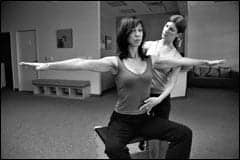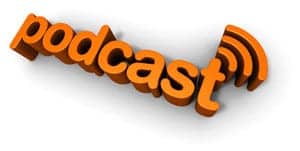 |
| A physical therapist assists her client with posture exercises using a Pilates fitness chair. |
It has happened time and time again. A client shuffles gingerly through the door hunched over in agony, a back ailment obviously the culprit. “How did it happen?” I ask. The answer is a surprisingly similar one: “I bent over to pick up the paper.” Such is the case for the average person and weekend warrior. It is rarely an act of hard physical labor or athletic overexertion that has caused their back to go out, but a simple physical movement made unexpectedly.
At our practice we see a tremendous number of clients who have developed back problems as a direct result of muscular imbalances in their pelvis. When combined with poor body mechanics, the diminished strength and decreased body awareness—especially in the core—can cause weak or unconnected spinal stabilizers within many clients.
One of the most effective means of rehabilitation (and prevention) for those with potential back problems has been Pilates exercise. Pilates conditions the whole body, with an emphasis on correct alignment, muscular balance, body awareness, and movement efficiency. The result is the creation of an entire musculature that is more evenly balanced and conditioned, decreasing the chances of injury resulting from a “postural imbalance setup.” Overall, it helps clients enjoy daily activities with greater ease.
As children, we were flexible and most movements were not harmful. But as we grew older and participated in certain activities, the body was set up to take on certain postures. Performed repetitively, these postures overused certain muscles, weakened others, and led to an altered sense of body awareness and proper alignment. All of which are precursors to a back injury.
Identifying improper patterns of both static and dynamic posture or positioning in an individual is the starting point for improving posture. The question of how imbalances begin is one that can baffle and frustrate clients. Therefore, we frequently reframe our approach to determine how we can improve their current posture. As clients increase their understanding of neutral pelvic and spinal alignment, their postural awareness begins to improve greatly. The more proficient clients get in thinking about their body positions and mindful movements, the easier it becomes for them to identify good and bad alignment. Once they have this awareness, they can make adjustments on their own.
In order to correct bad postural position, we need to understand what good posture is and how to maintain it. As most of us know, good posture does not necessarily mean standing erect. Good posture is awareness of where your spine needs to be and maintaining it in a variety of different positions. It is having balance within the cervical, thoracic, and lumbar curvatures of the spine. The size and degree of those curves vary from person to person, but the bottom line is that these curves need to be in as much balance as possible in standing, sitting, and lying down.
When postural balance is not attained, muscle imbalances occur. For example, if a client has a flattened curve within the lumbar spine, the muscles on the front of the pelvis and the single joint hip flexors become elongated and weak, while the hamstring muscles are tight and shortened. Conversely, if you have a large curve in the lower back (ie, military-type posture), the hip flexors and low back muscles are short and strong while the anterior abdominals and the hamstrings are elongated and weak.
PRECARIOUS MOVEMENTS
Once muscle imbalances have developed, a rudimentary movement can cause injury. When undertaking a hard labor activity like landscaping or moving a heavy household item, the chance of injury is sometimes reduced since most people have a tendency to be more aware of their bodies as they know there is going to be a strain on them. It is the benign activities, like leaning over to pick up kids or fielding an easy ground ball in a softball game, that usually cause the damage.
Conditioning of the core muscles is a vital step toward correcting faulty postures, increasing flexibility, and improving strength in order to heal or prevent low back injury. The PT mantra that “proximal stability is needed for distal mobility” basically translates to “a strong core is imperative to having efficient and functional movement of your arms and legs.” Proprioceptive awareness also is greatly improved by working the core.
In Pilates, a client first learns to work through the core of the body and then through the extremities. The core is considered the deep abdominal muscles, the pelvic floor along with the muscles closest to the spine, and the use of the diaphragm for proper breathing. Control of the core is achieved by integrating the trunk, pelvis, and shoulder girdle.
Pilates emphasizes postural alignment and awareness. It teaches a body how to maintain alignment through a specific movement sequence in an exercise. The nature of Pilates’ choreography is a combination of flexibility and strength training with postural awareness and control.
Because it encourages body awareness and connection, Pilates is an exceptional form of rehab for weekend warriors. Clients learn how to facilitate proper and balanced recruitment of muscles to minimize inefficient patterns of movement. The body is trained to support itself throughout a wide range of motions while lying, sitting, standing, or kneeling. The exercises, which can be done on a mat or on Pilates equipment, such as the Reformer, emphasize proper breathing, correct spinal and pelvic alignment, and complete concentration on smooth, flowing movement.
The advantage of this approach to conditioning is that people with painful conditions, who might be at risk with certain forms of strength and stabilization training, are able to get back in shape without risking further injury. Clients become acutely aware of how their body feels, where it is in space, how to control their movement in correct alignment, and using good body mechanics. Our approach is to emphasize the quality of movements as opposed to the number of repetitions. What is also appealing about Pilates as a form of exercise, prevention, or rehabilitative training is the personalized nature of the work. Programs are developed with particular attention to the specific needs of the individual.
Dawn Marie Ickes, MPT, has taught workshops in pediatrics, prosthetics, and women’s health, in addition to developing educational programs for health care professionals integrating Pilates and rehabilitation. She is on the board of directors for the Pilates Method Alliance and is also co-owner of CoreConditioning (Studio City, Calif), a multidisciplinary studio integrating Pilates and Gyrotonic® with leading-edge rehabilitation techniques. She can be reached at .
PILATES TREAT A BULGING DISK
The following is a case study using Pilates as a method of rehabilitation for a bulging disc:
Madeleine, a 36-year-old animator was referred for treatment of low back pain due to a bulging disc. Her pain level was reported at 7/10 with radiating pain in her left leg. Her evaluation revealed active range of motion (AROM) for lumbar flexion was limited by pain to 15% of the normal range of motion (ROM) for flexion with all of the motion coming from L1. She was unable to side-bend to the left and limited at 15% of normal to the right. Rotation left was limited to 20% of normal ROM, and to the right at 50% of normal. She exhibited a positive straight leg raise on the left at 15 degrees of elevation from supine position.
The client’s first two sessions included soft tissue work and joint mobilization techniques and she learned to contract and connect to her inner unit. She was given isometric transverse abdominus and pelvic floor exercises to begin her home program. She was introduced to lumbo-pelvic stretching and footwork on the reformer.
By the sixth session, her straight leg raise had increased to 35 degrees and her pain level was much lower at 4/10. She received tactile and verbal curing as needed throughout each exercise with diminishing levels of input based on his performance.
By her twelfth visit, the client’s therapeutic exercise program included the following exercises on the Reformer (REF), Trapeze Table (TRAP) and Pilates fitness chair (PC):
- Footwork (REF)
- Arm circles (REF)
- Leg in strap (REF boxes, straight leg elevation to 30 degrees, frogs)
- Pulling straps
- Seated on moon box, (an upholstered box used with a Trapeze table, Reformer, and Pilates chair) lat draw downs (TRAP)
- Seated chest expansion (REF)
- Quadruped abdominals in pelvic neutral (REF)
- Swan (PC)
—Dawn Marie Ickes, MPT




